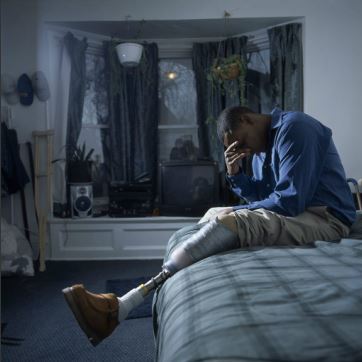October 1, 2014 - 00:16


At first glance, it is evident that Nina Berman framed this portrait with her subject’s prosthetic leg as the focal point. The angle at which he is sitting (and the fact that the pant leg is rolled all the way up) give a very clear view of the entire leg, and its angling makes it appear larger, as we saw last week with the portrait of Christopher Reeve in which his wheelchair was made to seem dramatically larger than his body (here, his foot appears to be the closest to the viewer). Of not also is that the portrait is literally framing the prosthetic leg; that is to say that the leg is exactly in the center of the picture. The overall message of the image is a negative one; our subject is in a position that clearly depicts stress; notably, his face is not visible.
The picture comes from Nina Berman’s Purple Heart series, a series of "portraits of veterans wounded in the Iraq war photographed at their homes, ..." (see description on http://www.ninaberman.com/purple-hearts) so presumably his amputation came as a result of an injury sustained in war. Thus, from his positioning his unhappiness is evident; it is also highlighted by the color palette of grays and blues. Since his face isn’t showing, it is possible as well that he is more than just upset—that, just as his identity is not visible to us, so he might feel that he has lost some measure of his identity. Indeed, only the amputated leg is visible, indicating that the war-inflicted disability of one leg is more defining than the ability of the other. (I am working here under the assumption that his other leg does not have a prosthetic; although we are clearly uncertain, this seems the most reasonable conclusion to draw from its erasure—I am wary in doing so, but I have a hard time imagining why Berman would omit one if both legs were injured during his time in war.)
His positioning and the mood evoked take us back to several other points we’ve discussed in class: although the portrait may be an honest representation of his emotions, it is still clearly negative, once again reinforcing the image of the soldier as the martyr as well as the privilege that comes from having a recognizable, physical disability that can easily be rooted to a distinct cause illustrated by the very title of the series.
Looking specifically at his costuming and the costuming of his surroundings, we see a slice of him in what his day-to-day life, one nearly identical to his life pre-disability save for the crutches in the background (and potentially a cane behind his back; I can’t quite tell?). His clothing is especially telling: by wearing the average clothing of someone in a professional setting, one identity—that of a normative, nondescript person—is made visible. Meanwhile, the other—that of someone with a disability—is easily hidden; were we to see him in this outfit with the pant leg rolled down, his disability would become invisible. In rolling up his pant leg, this “secret,” concealable identity is made visible, as if we are being exposed to a private and vulnerable part of him. In this way, Berman also takes us back not only to the trope of the soldier with the tragic story but also to the idea that such a disability is not merely one to be mourned but also one to be hidden.
It seems that this portrait is intended to be an honest depiction of the subject’s attitude and life. It is indeed a photograph, which seems to be one of the most accurate mediums in that, however manipulated the subject may be in relation to color, pose, and surroundings, the photo will still capture him physically as he is--especially since, based on the description of the series, we are led to believe that he is in his own home. But much is lost when we focus on the negative, when we continue to see disability through an ableist lens by depicting stories in which an acquired disability is an acquired tragedy. Where is the line drawn in this field of ethics? How can we portray a soldier’s story honestly but without romanticizing it or falling into tropes that ultimately serve only to further the attitude that disability is heartbreaking? In another direction—is this story something we should even concern ourselves with? Is it one worth sharing? Or should we instead be finding other stories to illustrate?
